
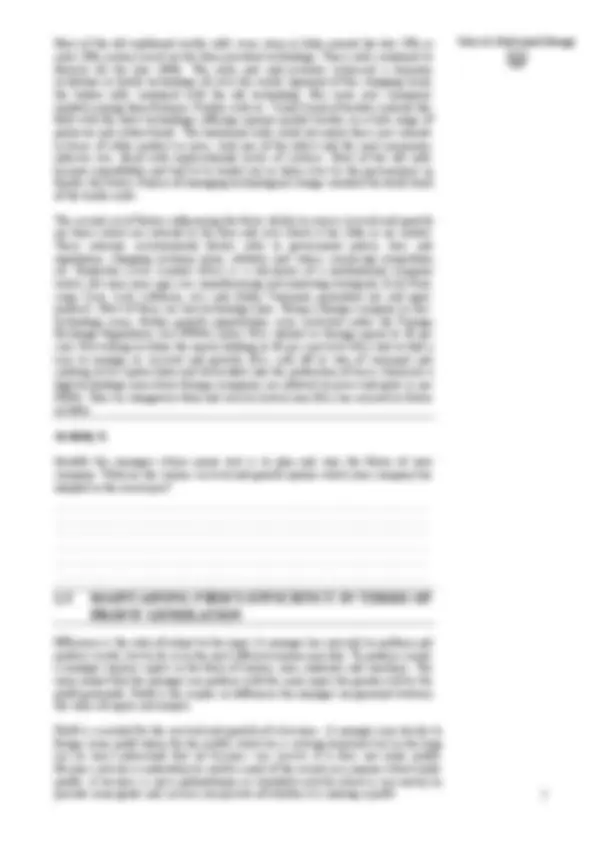
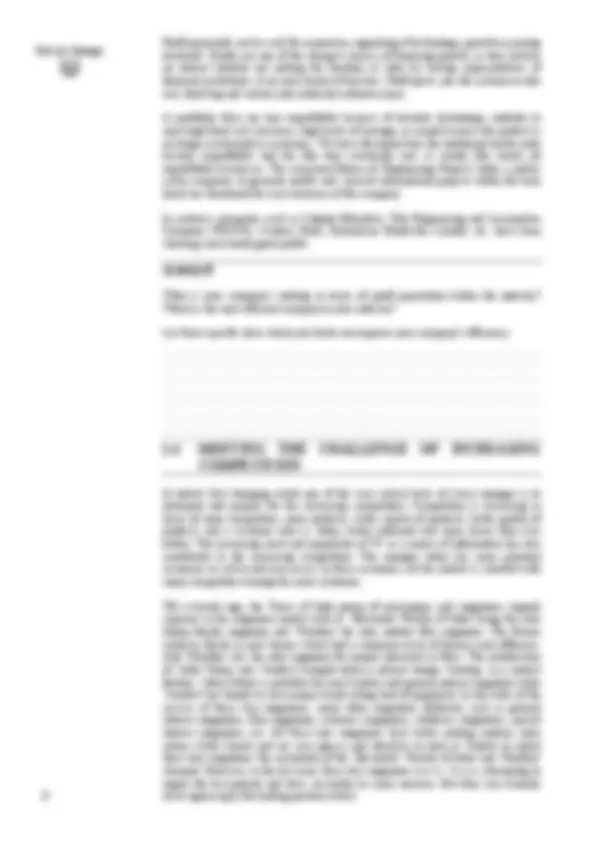
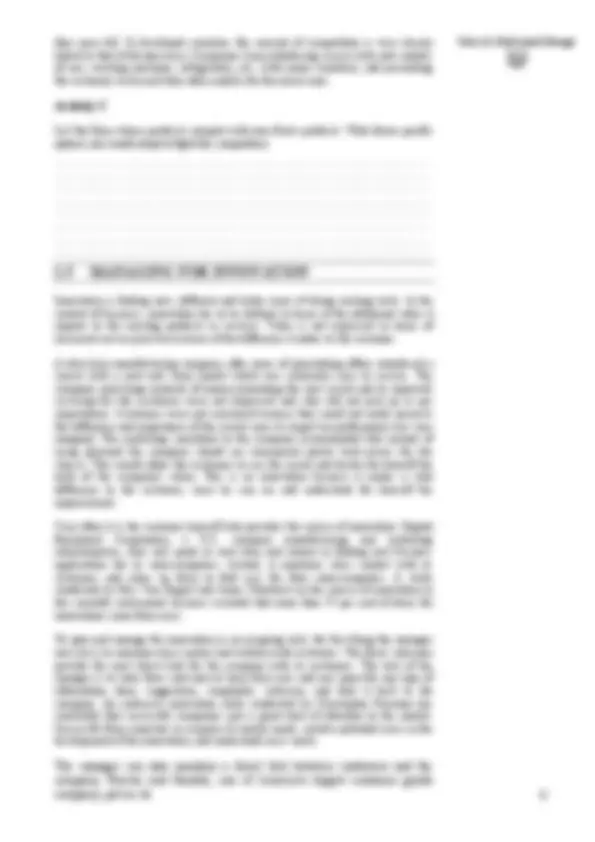
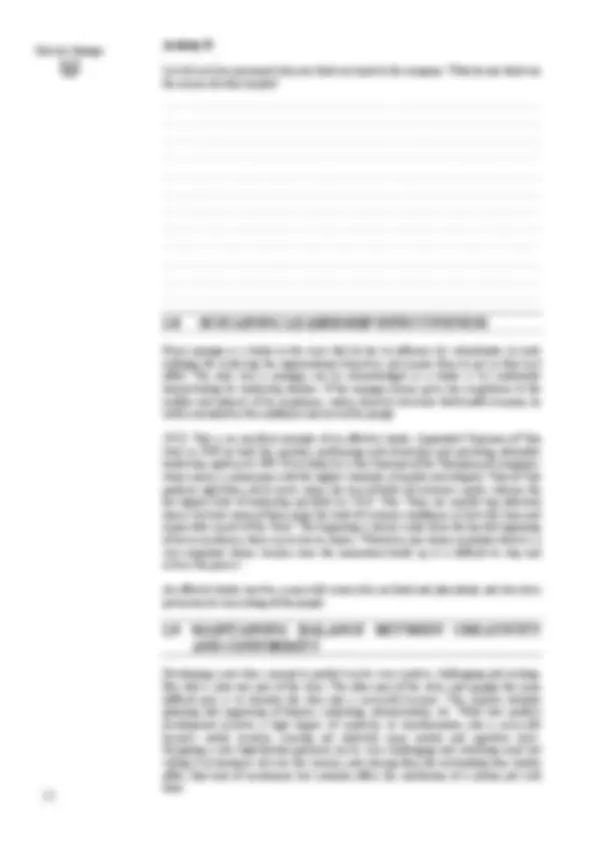
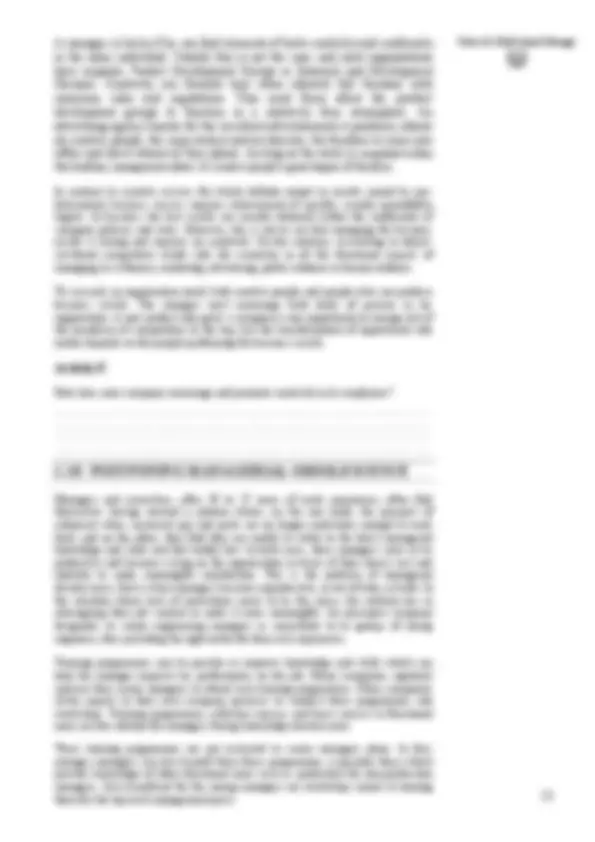
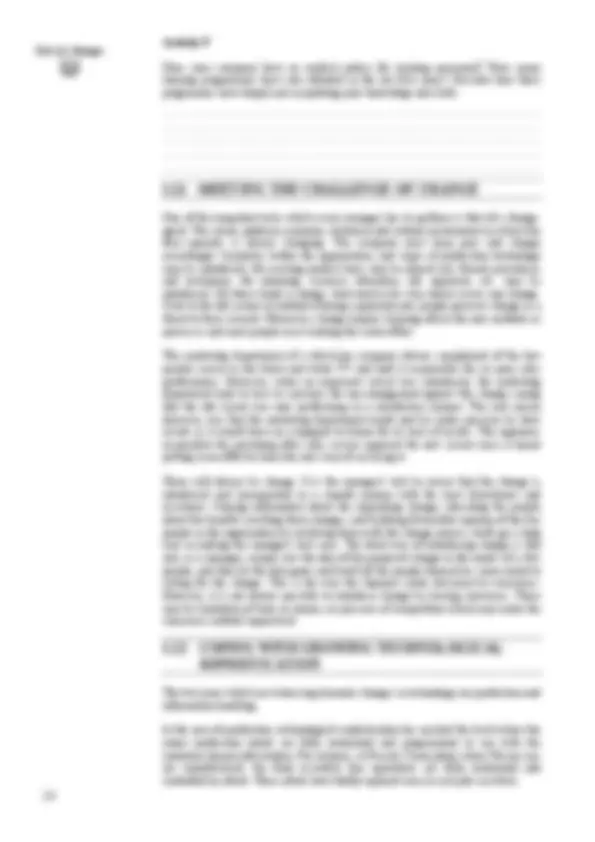
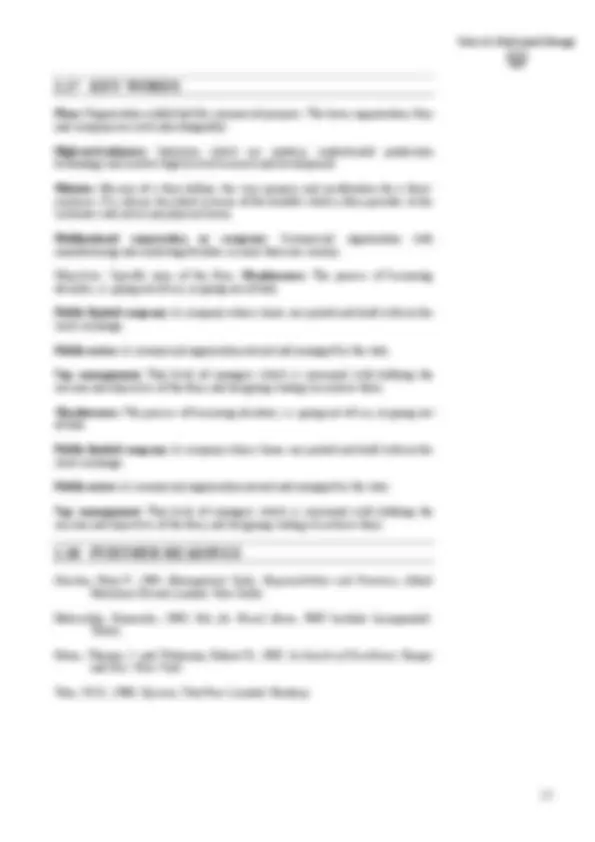


Study with the several resources on Docsity

Earn points by helping other students or get them with a premium plan


Prepare for your exams
Study with the several resources on Docsity

Earn points to download
Earn points by helping other students or get them with a premium plan
Community
Ask the community for help and clear up your study doubts
Discover the best universities in your country according to Docsity users
Free resources
Download our free guides on studying techniques, anxiety management strategies, and thesis advice from Docsity tutors
study material for IGNOU management course
Typology: Study notes
1 / 13

This page cannot be seen from the preview
Don't miss anything!








Tasks of a Professional Manager
Objectives
The objectives of this unit are to enable you:
Structure 1.1 Providing Purposeful Direction to the Firm
1.2 Managing Survival and Growth
1.3 Maintaining Firm's Efficiency in Terms of Profit Generation 1.4 Meeting the Challenge of Increasing Competition
1.5 Managing for Innovation
1.6 Building Human Organisation 1.7 Retaining Talent and Inculcating Sense of Loyalty
1.8 Sustaining Leadership Effectiveness
1.9 Maintaining Balance Between Creativity and Conformity 1.10 Postponing Managerial Obsolescence
1.11 Meeting the Challenge of Change
1.12 Coping with Growing Technological Sophistication 1.13 Coping with Growing Public Criticism and Political Opposition-both Objective and Irrational 1.14 Coping with Increasing Levels of Aspiration
1.15 Maintaining Relations with Various Society Segments
1.16 Summary 1.17 Key Words
1.18 Further Readings
As a participant in this programme you are either a practising manager or are aspiring to be one. Your, first concern, therefore, is to know the tasks which you are expected to fulfill as a professional manager. These various tasks are discussed in this unit.
There is a lot of confusion over the much widely used terms-professional management and professional managers. Some researchers contend there is nothing like professional management. Management is a discipline. There are practitioners of this discipline who practise management as a profession and 'thus are, professional managers. Just as there are doctors and lawyers by profession similarly there are professional managers. As doctors practise medicine, managers practise management. The only difference between professional managers and other professionals is that, while the latter must possess a formal degree in their discipline, a^ professional manager need not have a formal degree or education in management. He may have learnt the necessary skills and gained competence from his experience. The second characteristic of a professional manager is that his primary concern is the organisation or the company with which he works. This is true whether the manager works for a private or public sector or a multinational company; whether he is the executive director or the personnel manager reporting to the executive director. The professional manager always has his company's overall perspective in his mind and all his actions are guided by the company's objectives.
The third and the most important characteristic of a professional manager is that he is responsible for performance. Managing involves collecting and utilising resources
Role of a Manager (^) of some pre-determined objectives or results. It is the professional manager's
responsibility to utilise resources to produce the required results. Responsibility and performance are really the key words in defining a manager's role. Performance implies action, and action necessitates taking specific steps and doing certain tasks. Let us first take up the various tasks which a manager is expected to do to produce results.
1.1 PROVIDING PURPOSEFUL DIRECTION TO THE FIRM
A manager can be compared to the captain of a ship who has first to set the course to reach the destination and then steer the ship along the course. Similarly, a manager has to, first of all, set objectives which the firm must achieve. Objectives provide the direction in which the firm must move. Having decided upon the objectives, the manager must constantly monitor the progress and activities of the firm to ensure that it is moving in the desired direction. This is the first and foremost task of every manager.
If you are a part of the top management team then you will be very actively involved in this task through the process of defining the mission and objectives for the entire organisation. If you are a manager reporting to the top manager, it is your task to see that the actions of the people who work for you in your department or division are in the desired direction. It is your task as a manager to prevent all such actions which take your company away from the direction set by the top management.
A large American multinational company has its subsidiary in India which manufactures and markets a popular line of cosmetics and cough and cold medication. It maintains a large farm in Uttar Pradesh for production of a medicinal plant which is used as an active ingredient in all its medication. Control over this essential raw material gives the company a substantial cost advantage. To derive further cost advantage it was proposed that the company set up its own printing press for printing the packaging labels. The proposal was in the final stage of approval till the top management team realised that printing was not their business. Diversification into printing would only .take the company farther away from, and not closer to, the desired direction. Production and marketing of medication was their main line of business and the farm made an essential contribution. However., printing was not such a critical activity that it required the company to have full control over it.
This illustration highlights the fact that all actions and decisions must be evaluated on the basis of their contribution towards achievement of the company's objectives. However, this illustration should not give you the idea that objectives or direction once set will hold good for all times to come or that any movement away from the current line of production or activity is always undesirable. The key point is that all movements and actions must be consistent with achievement of the objectives. To ensure consistency it is important that the manager carefully thinks through each alternative course of action, to evaluate its potential to contribute towards attainment of objectives.
1.2 MANAGING SURVIVAL AND GROWTH
"Survival of the fittest" is the law of the jungle which is equally applicable to the competitive market place where firms struggle and fight for survival. Ensuring survival of the firm is a critical task of the manager. But that alone is not enough. The manager has also to actively seek growth. No matter how big or powerful a firm may be today, it is sure to be left behind in the race by newer, healthier and more efficient firms if it does not pursue growth.
Two sets of factors impinge upon the firm's survival and growth. The first is the set of factors which are internal to the firm and are largely controllable. These internal factors are choice of technology, efficiency of labour, competence of managerial staff, company image, financial resources, etc.
Profit generated can be used for expansion, upgrading of technology, growth or paying dividends. Profits are one of the cheapest sources of financing growth, as they involve no interest liability nor putting the freedom at stake by having representatives of financial institutions sit on your board of directors. Profit gives you the cushion to take risk, think big and venture into relatively unknown areas.
Role of a Manager
A profitable firm can turn unprofitable because of obsolete technology, inability to meet high fixed cost structures, high levels of wastage, or simply because the product is no longer in demand by customers. We have illustrated how the traditional textile mills became unprofitable and the fate they eventually met. A similar fate awaits all unprofitable businesses. The consistent failure of, Engineering Projects India, a public sector company, to generate profits and. execute international projects within the time limits has threatened the very existence of this company.
In contrast, companies such as Colgate-Palmolive, Tata Engineering and Locomotive Company (TELCO), Century Enka, Richardson Hindustan Limited, etc. have been showing consistently good profits.
What is your company's ranking in terms of profit generation within the industry? Which is the most efficient company in your industry?
List three specific ideas which you think can improve your company's efficiency. …………………………………………………………………………………………. …………………………………………………………………………………………. …………………………………………………………………………………………. …………………………………………………………………………………………. …………………………………………………………………………………………. …………………………………………………………………………………………. ………………………………………………………………………………………….
1.4 MEETING THE CHALLENGE OF INCREASING COMPETITION
In today's fast changing world one of the very critical tasks of every manager is to anticipate and prepare for the increasing competition. Competition is increasing in terms of more competitors, more products, wider variety of products, better quality of products and a customer who is, today, better informed and more aware than ever before. The increasing reach and popularity of TV as a means of information has also contributed to the increasing competition. The manager today has more potential customers to sell to and easy access to these customers yet the market is crowded with many competitors wooing the same customers.
Till a decade ago, the Times of India group of newspapers and magazines reigned supreme in the magazine market with its Illustrated Weekly of India' being the only Indian family magazine andFilmfare' the only notable film magazine. The former could be found in most homes which had a minimum level of literacy and affluence. And Filmfare' was the only magazine for people interested in films. The introduction ofIndia Today' and Stardust' brought about a radical change. Starting in a modest fashion.India Today' is probably the most widely read general interest magazine while Stardust' has blazed its own unique trend-setting trail of popularity. In the wake of the success of these two magazines, many other magazines followed, such as general interest magazines, film magazines, women's magazines, children's magazines, special interest magazines, etc. All these new magazines have better reading content, more colour, better layout and are very glossy and attractive to look at. Unable to match these new magazines the circulation of theIllustrated. Weekly of India' and `Filmfare' slumped. However, in the last years these two magazines h a v e b e e n attempting to regain the lost ground and have succeeded to some measure. But they can certainly never again enjoy the leading position which
they once did. In developed countries the concept of competition is very closely^ Tasks of a Professional Manager linked to that of obsolescence. Companies keep introducing successively new models of cars, washing machines, refrigerators, etc., with minor variations, and persuading the customers to discard their older models for the newer ones.
List the firms whose products compete with your firm's products. Write down specific options you would adopt to fight this competition.
…………………………………………………………………………………………. …………………………………………………………………………………………. …………………………………………………………………………………………. …………………………………………………………………………………………. …………………………………………………………………………………………. …………………………………………………………………………………………. …………………………………………………………………………………………. ………………………………………………………………………………………….
1.5 MANAGING FOR INNOVATION
Innovation is finding new, different and better ways of doing existing tasks. In the context of business, innovation has to be defined in terms of the additional value it imparts to the existing products or services. Value is not expressed in terms of increased cost or price but in terms of the difference it makes to the customer.
A television manufacturing company, after years of painstaking effort, introduced a circuit with a neat and clean layout which was extremely easy to service. The company spent large amounts of money promoting this new circuit and its improved servicing but the customers were not impressed and sales did not pick up as per expectations. Customers were not convinced because they could not really perceive the difference and importance of the circuit since its impact on performance was very marginal. The marketing consultant to the company recommended that instead of using plywood the company should use transparent plastic back-covers for the chassis. This would allow the customers to see the circuit and decide for himself the truth of the company's claim. This is an innovation because it makes a vital difference to the customer, since he can see and understand for himself the improvement.
Very often it is the customer himself who provides the source of innovation. Digital Equipment Corporation, a U.S. company manufacturing and marketing minicomputers, does not spend its own time and money in finding new business applications for its mini-computers. Instead, it maintains close contact with its customers and relies on them to find uses for their mini-computers. A study conducted by Eric Von Hippel and James Utterback on the source of innovation in the scientific instruments business revealed that more than 75 per cent of ideas for innovations came from users.
To plan and manage for innovation as an on-going task, the first thing the manager must do is to maintain close contact and relation with customers. The firm's salesmen provide the most direct link for the company with its customers. The task of the manager is to train these salesmen to keep their eyes and ears open for any type of information, ideas, suggestions, complaints, criticisms, and feed it back to the company. An extensive innovation study conducted by Christopher Freeman has concluded that successful companies pay a great deal of attention to the market. Successful firms innovate in response to market needs, involve potential users in the development of the innovation, and understand users' needs.
Tasks of a Professional Manager
Realising the importance of creating a team spirit and teamwork for achieving the organisational objectives, progressive companies are trying to build this up in every possible way. Quad Graphics, a very successful print company in USA, calls its workers partners'. W.L. Gore Associates, an American high-tech manufacturer refers to its 4000 people on its payrolls asassociates". Over 8,000 American companies share part of their ownership with more than 10 million employees through Employee Stock Ownership Plans.
1.7 RETAINING TALENT AND INCULCATING SENSE
OF LOYALTY
Hiring good people is still a relatively simple task as compared to the task of retaining them, people may join a company because of its favourable image but will stay on only if they find appreciation for, and satisfaction from, their work.
To retain talented people the manager should provide a comfortable working environment which is conducive to work. More important than the physical environment is the degree of freedom which a worker enjoys in making decisions within the defined parameters of his job. When a worker knows that it is his responsibility to produce results and he is accountable for them, he will put in his best effort. On the other hand, if the worker is always ordered to do every single act, and nothing is left for him to decide, whatever little potential exists in him will be killed. A worker should be able to take pride in his work, derive satisfaction from saying `This is my achievement'. To ensure that work does not degenerate into a boring and meaningless affair, repetitive, dull tasks should be interspersed with tasks which call for some element of creativity. In practice this may be difficult, but the manager must at least give some thought to how best he can make work meaningful. Rotating jobs within the same department at the same level may be one way of making work more interesting and provide opportunity to the worker to demonstrate his professional and technical skill.
The manager must also understand that each individual is unique and his degree of expertise at handling various aspects of works varies from that of another. As an effective manager your attempt should be to pinpoint your subordinates' strengths and give them work in which their skill can be utilised to the maximum. In areas where they feel inadequate, provide them support. A talented, competent man is definitely worth that bit of extra support.
Recognising, appreciating and nurturing your subordinates' talents will bring you rewards in terms of improved results and loyalty. However, to really earn the loyalty of his people the manager must remember two other key concepts, communication and motivation. A manager who encourages open, direct and frank communication is always able to tackle issues much before they become problems and also take advantage of the creative ideas of his employees. Opportunity to communicate directly with the top manager enhances the sense of self-esteem of workers and helps create in them a sense of belonging, a feeling that what they think and feel is important to their organisation. Such a feeling goes a long way in building loyal employees.
Every individual's behaviour is initiated because of some needs, drives, and desires and is directed towards achievement of goals. These needs and drives motivate a man to action. The manager's attempt should be to influence these needs, desires or motives towards the achievement of the organisational goals. The more such motivational factors a manager can incorporate in the work content, environment of work and rewards of work, the more willingly will people put in hard work. Money, power, status, recognition, etc. are all powerful motivators which a manager can use. Under the Employees Stock Ownership Plans in use in many U.S. companies, employees can buy shares and become part owners of the companies for which they work. Recent research reveals that these plans encourage employees to remain loyal. to their organisations and stay on with them.
Role of a Manager
List all such key personnel who you think are loyal to the company. What do you think are the reasons for their loyalty?
…………………………………………………………………………………………. …………………………………………………………………………………………. …………………………………………………………………………………………. …………………………………………………………………………………………. …………………………………………………………………………………………. …………………………………………………………………………………………. …………………………………………………………………………………………. …………………………………………………………………………………………. …………………………………………………………………………………………. …………………………………………………………………………………………. …………………………………………………………………………………………. ………………………………………………………………………………………….
1.8 SUSTAINING LEADERSHIP EFFECTIVENESS
Every manager is a leader in the sense that he has to influence his subordinates to work willingly for achieving the organisational objectives and inspire them to put in their best effort. The only way a manager can be acknowledged as a leader is by continually demonstrating his leadership abilities. If the manager always gives due importance to the welfare and interests of his employees, makes objective decisions that benefit everyone, he will be rewarded by the confidence and trust of his people.
J.R.D. Tata is an excellent example of an effective leader. Appointed Chairman of Tata Steel in 1939 he held this position, performing with distinction and providing admirable leadership, right up to 1985. Even today he is the Chairman of the Tata group of companies, whose name is synonymous with the highest standards of quality and integrity. That all Tata products right from salt to trucks enjoy, the trust of lakhs of customers speaks volumes for the highest kind of leadership provided by J.R.D. Tata. There are equally big industrial houses but how many of them enjoy the kind of customer confidence or have the clean and impeccable record of the Tatas? The beginning is always made from the top-the beginning of rot or excellence, that is up to you to choose. Whichever you choose remember that it is. a very important choice, because once the momentum builds up it is difficult to stop and reverse the process.
An effective leader must be a man with vision who can think and plan ahead, and also have persuasion to carry along all the people.
1.9 MAINTAINING BALANCE BETWEEN CREATIVITY AND CONFORMITY
Developing a new idea, concept or product can be very creative, challenging and exciting. But, that is only one part of the story. The other part of the story, and usually the more difficult part, is to translate this idea into a successful business. This requires detailed planning and organising of finance, marketing, administration, etc. While new product development involves a high degree of creativity, its transformation into a successful business reality involves carrying out relatively more routine and repetitive tasks. Designing a new high-fashion garment can be very challenging and satisfying work but selling it to boutiques all over the country, and chasing them for outstanding dues hardly offers that kind of excitement, but certainly offers the satisfaction of a routine job well done.
Activity F
Role of a Manager
Does your company have an explicit policy for training personnel? How many training programmes have you attended in the last five years? Describe how these programmes have helped you in updating your knowledge and skills. …………………………………………………………………………………………. …………………………………………………………………………………………. …………………………………………………………………………………………. …………………………………………………………………………………………. ………………………………………………………………………………………….
1.11 MEETING THE CHALLENGE OF CHANGE
One of the important tasks which every manager has to perform is that of a change- agent. The social, political, economic, technical and cultural environment in which the firm operates is always changing. The company must keep pace and change accordingly. Similarly, within the organisation, new types of production technology may be introduced, the existing product lines may be phased out, formal procedures and techniques for planning, resource allocation, job appraisal, etc. may be introduced. All these imply a change. And man by his very nature resists any change. Used to the old system or method of doing a particular job, people perceive change as a threat to their security. Moreover, change implies learning afresh the new methods or processes and most people resist making this extra effort.
The marketing department of a television company always complained of the low quality circuit in the black and white TV and held it responsible for its poor sales performance. However, when an improved circuit was introduced, the marketing department tried its best to convince the top management against this change saying that the old circuit was now performing in a satisfactory manner. The real reason however, was that the marketing department would now be under pressure to show results as it would have no scapegoat to blame for its lack of results. The engineers responsible for providing after sales service opposed the new circuit since it meant putting in an effort to learn the new way of servicing it.
There will always be change. It is the manager's task to ensure that the change is introduced and incorporated in a smooth manner with the least disturbance and resistance. Sharing information about the impending change, educating the people about the benefits resulting from changes, and building favourable opinion of the key people in the organisation by involving them with the change process itself, go a long way in making the manager's task easy. The ideal way of introducing change is that you, as a manager, simply sow the idea of the proposed change in the minds of a, few people, and then let the idea grow and build till the people themselves come round to asking for the change. This is the way the Japanese make decisions-by consensus. However, it is not always possible to introduce change by having consensus. There may be limitation of time or money, or pressure of competition which may make the consensus method impractical.
1.12 COPING WITH GROWING TECHNOLOGICAL SOPHISTICATION
The two areas which are witnessing dramatic changes in technology are production and information handling.
In the area of production, technological sophistication has reached the level where the entire production plants are fully automated and programmed to run with the minimum human intervention. For instance, at Nissan's Zama plant, where Nissan cars are manufactured, the final assembly line operations are fully automated and controlled by robots. These robots have totally replaced men in such jobs in which
the former can be programmed to perform round the clock without any fatigue or loss^ Tasks of a Professional Manager of efficiency. Robots are also being used in manufacturing which requires handling of bulky and dangerous materials. All these changes in production techniques have forced managers to find ways and means of relocating the workers rendered redundant. Simply laying off is not always the best solution as it can involve a very high compensation cost. Moreover, in many countries because of the government's political ideology or cultural values (as in Japan where the concept of employment with a company is life-long), laying off workers is not permissible.
The use of computers in business has totally changed the way that managers make decisions. Managers today not only have access to more updated information but also better information which can improve quality of their decisions. Moreover, with electronic data processing managers can use complex statistical and mathematical models and tools to study the possible impacts of their decision. All this helps lessen the degree of risk by reducing the level of uncertainty. However, access to more information places the onus on the manager to define what is the relevant information that he needs and also ensure that the benefit derived from the information which he receives is greater than the cost incurred in collecting and processing it.
1.13 COPING WITH GROWING PUBLIC CRI TICIS
AND POLITICAL OPPOSITION-BOTH OBJECTIVE AND IRRATIONAL
Large business groups are often the target of political and public criticism because of their apparent power and clout arising out of concentration of economic power. By Indian standards this economic power may seem great but is very small by international standards. The criticism is not always evoked by facts but because of ideological, political or personal reasons. But sometimes the criticism may be founded (fl facts as in the recent case of the Reliance Textiles, attempts to corner large : amounts of loans from various nationalised banks. Similarly, Peerless General Finance Limited was the subject of controversy and criticism on account of amassing large amounts of funds without following proper procedures.
1.14 COPING WITH INCREASING LEVELS OF
ASPIRATION
Improvement in information technology is resulting in an increasing trend towards democratisation of the society. People in one part of the world know more about peoples and events in other parts of the world. Similarly, people belonging to one socio-economic segment of society know more than ever before the life styles of people in higher socio-economic segments. Exposed to a better quality of life and a better life style, people from the lower economic segments, especially the younger people, aspire to the same kind of life style.
A manager must bear this fact in mind while dealing with blue-collar workers because these is bound to be a vast gap between their levels of aspiration and reality. If the manager is ignorant and insensitive to this gap, the workers' resentment and frustration is bound to spill over in ways which can prove disruptive and destructive to the firm's working.
You, as the manager, must understand the nature of aspiration of your workers and try to fulfil them, as far as possible, within the framework of the company and the worker's job. Giving more autonomy, responsibility, money, status and enhancing the worker's sense of self-esteem through participation in management decisions can channelise his latent or potential resentment towards more productive ends.
Tasks of a Professional Manager
1.17 KEY WORDS
Firm: Organisation established for commercial purpose. The terms organisation, firm and company are used interchangeably.
High-tech-industry: Industries which use modern, sophisticated production technology and involve high level of research and development.
Mission: Mission of a firm defines the very purpose and justification for a firm's existence. It is always described in terms of the benefits which a firm provides to the customers and not in any physical terms.
Multinational corporation or company: Commercial organisation with manufacturing and marketing facilities in more than one country.
Objectives: Specific aims of the firm. Obsolescence: The process of becoming obsolete, i.e. going out of use, or going out of date.
Public limited company: A company whose shares are quoted and dealt with on the stock exchange.
Public sector: A commercial organisation owned and managed by the state.
Top management: That level of managers which is concerned with defining the mission and objectives of the firm, and designing strategy to achieve them.
Obsolescence: The process of becoming obsolete, i.e. going out of use, or going out of date.
Public limited company: A company whose shares are quoted and dealt with on the stock exchange.
Public sector: A commercial organisation owned and managed by the state.
Top management: That level of managers which is concerned with defining the mission and objectives of the firm, and designing strategy to achieve them.
1.18 FURTHER READINGS
Drucker, Peter F., 1981. Management Tasks, Responsibilities and Practices, Allied Publishers Private Limited: New Delhi.
Matsushita, Konosuke, 1983. Not for Bread Alone, PHP Institute Incorporated: Tokyo.
Peters, Thomas, J. and Waterman, Robert H., 1985. In Search of Excellence, Harper and Row: New York.
Tata, J.R.D., 1986. Keynote, Tata Press Limited: Bombay.
for Bread Alone, PHP Institute Incorporated: Tokyo.